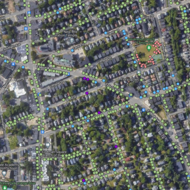The urban forest is an important part of the City’s landscape. It’s made up of all the trees on public and private land in Boston, along with the City’s shrubs, grasses, ground cover, soil, and waterways.

Urban Forestry Division
Street Tree Inventory
The Urban Forestry Division is working to maintain updated information on the city’s almost 40,000 street trees. Explore the inventory to learn about trees in your neighborhood and see some of the recent work done by the division.
Public Tree Ordinance
Request a Tree Removal Hearing
If you need to remove a street tree for construction or another reason, you must follow the process in accordance with Massachusetts General Law 87.
Participate in the Public Tree Ordinance Process
Find out how to join a public meeting or comment about a proposed tree removal, along with other helpful information about the ordinance.
Urban Forestry Advisory Committee
Learn about the structure of the Advisory Committee and how to become a member.
Learn How to Care for Street Trees
Click here to explore the three key factors in tree care: Water, Mulch, and Stewardship.
| SCIENTIFIC NAME | COMMON NAME |
|---|---|
| Acer campestre | Hedge Maple |
| Acer truncatum 'Norwegian Sunset' | Norwegian Sunset Maple |
| Amelanchier laevis 'Cumulus' | Allegheny Serviceberry |
| Carpinus caroliniana | American Hornbeam |
| Crataegus inermis 'Thornless Cockspur' | Thornless Cockspur Hawthorn |
| Malus x 'Adirondack' | Adirondack Crabapple |
| Malus x 'Purple Prince' | Purple Prince Crabapple |
| Malus x 'Royal Raindrops' | Royal Raindrops Crabapple |
| Malus x 'Sugar Tyme' | Sugar Tyme Crabapple |
| Prunus subhirtella 'Autumnalis' | Higan Cherry |
| Prunus 'First Blush' | First Blush Cherry |
| Prunus 'Okame' | Okame Cherry |
| Prunus sargentii | Sargent Cherry |
| Prunus x yedoensis | Yoshino Cherry |
| Prunus virginiana 'Canada Red' | Canada Red Chokecherry |
| Syringa reticulata 'Ivory Silk' | Japanese Tree Lilac |
Programs and initiatives
Planning for future open space
The Parcel Priority Plan is a long-term visioning plan. We prioritize parcels of land to acquire and protect for public use.
Updating the seven-year open space plan
The City of Boston Open Space and Recreation Plan (OSRP) 2022-2028 will present the process, analysis, plan goals, and objectives for improving and protecting open space in Boston.
Franklin Park Action Plan
The Action Plan for Boston's largest greenspace—Franklin Park—is here!
Preparing for climate change
Green Infrastructure
Using plants, soil and other natural materials to remove pollutants and allow stormwater to absorb back into the ground, helping to prevent flooding among other benefits.
Healthy Places: Planning for heat, trees, and open space
What we are doing to increase open space, cool our neighborhoods, and protect Bostonians from the impacts of climate change.
Heat resiliency study
The study will identify strategies to address future impacts of extreme heat and increase citywide resilience.



